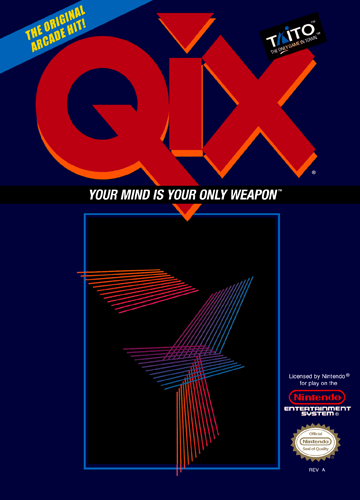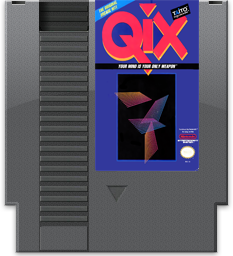

Qix, originally an arcade game developed by Taito, made its way to the Nintendo Entertainment System (NES) in 1991, bringing its addictive gameplay and unique concept to console players. Known for its simplicity and strategic depth, Qix challenged players to conquer territories while evading enemies in a fast-paced and intense experience. Let's dive into this classic title and see how it fares on the NES.
Year: 1991
Manufacturer: Taito Corporation
Genre: Action
Rating: HSRS - GA (General Audience)
Graphics:
Considering the NES's hardware limitations, Qix manages to impress with its clean and vibrant visuals. The game's minimalist design works to its advantage, allowing players to focus on the gameplay itself. The colors are well-utilized, and the enemy sprites are distinct and easy to recognize. While the graphics may not be groundbreaking by today's standards, they capture the essence of the original arcade version and provide a visually satisfying experience.
Gameplay:
Qix's gameplay is where it truly shines. The objective is to claim a certain percentage of the screen by drawing lines. Players must avoid enemies roaming around the playfield and strategically enclose areas to gain control. The concept may sound simple, but it quickly becomes challenging and addictive. As the levels progress, new enemy types are introduced, adding layers of complexity and requiring more strategic thinking. The controls are responsive, allowing for precise movements, which is crucial for success in the game. Qix's gameplay offers a great balance between simplicity and depth, making it easy to pick up but hard to master.
Sound and Music:
While the NES may not be renowned for its audio capabilities, Qix delivers an enjoyable auditory experience. The sound effects are satisfying, with each action accompanied by appropriate audio cues. The music, though limited in variety, fits the game's arcade atmosphere well, creating a sense of tension and excitement as players compete against the clock and enemies. The soundtrack may become repetitive over extended play sessions, but it never feels intrusive or distracting.
Replay Value:
Qix's replay value stems from its addictive gameplay and the desire to achieve higher scores. The game offers multiple difficulty levels, allowing players to tailor the experience to their skill level and increase the challenge as they improve. Moreover, Qix's simple mechanics and quick gameplay make it perfect for short bursts of play or longer sessions aiming to beat personal records. The high score leaderboard adds an additional layer of competitiveness for those who seek to climb the ranks and solidify their status as Qix masters.

Conclusion:
Qix for the NES successfully brings the addictive and strategic gameplay of the arcade original to the console platform. With its minimalist yet visually appealing graphics, engaging gameplay, and enjoyable audio, Qix remains a timeless classic that stands the test of time. Its simplicity and depth make it accessible to players of all skill levels, while the higher difficulty levels and score chasing provide a challenge for veterans. If you're a fan of retro arcade experiences or seeking a unique and captivating game, Qix for the NES is a title worth exploring.
Explore in-depth reviews and analyses of classic Nintendo Entertainment System (NES) games, including gameplay mechanics, graphics, sound, and overall nostalgic experience.